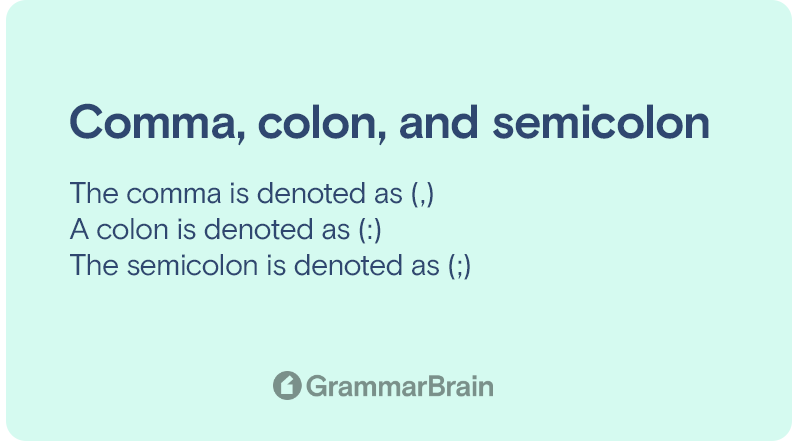What are the various types of punctuation marks? Punctuation is incredibly important in writing. Sentences without proper punctuation don’t make a lot of sense to readers. Note the use of periods in this paragraph. Imagine what it would be like to read this article without any punctuation marks like periods, commas, etc.
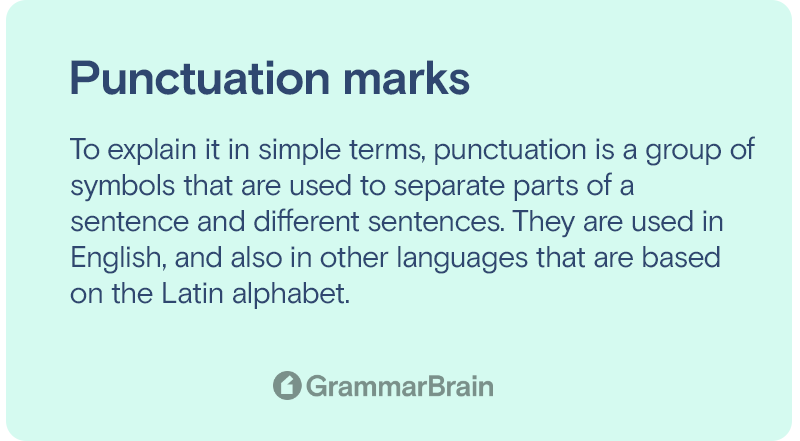
What is punctuation?
To explain it in simple terms, punctuation is a group of symbols that are used to separate parts of a sentence and different sentences. They are used in English, and also in other languages that are based on the Latin alphabet. It is a tool that makes it easier to organize one’s thoughts in a text and makes its meaning clearer for the reader. Every symbol used in this system is known as a punctuation mark.
Punctuation, along with structure, syntax, and word choice, makes writing more cohesive. The common types of punctuation used in the English language are commas, periods, question and exclamation marks, apostrophes, quotation marks, brackets, parenthesis, ellipses, colons, semicolons, hyphens, etc. More on these later. But let’s first take a look at typographical symbols.
| Form | Definition |
| Punctuation mark | Punctuation is the use of spacing, conventional signs, and certain typographical devices as aids to the understanding and correct reading of written text, whether read silently or aloud. |
What is a typographical symbol?
When we’re talking about symbols used in writing, it’s important to understand how typographical symbols work. Even though these are symbols, they are not considered to be punctuation marks.
They’re quite commonly found in informal writing, and in some instances in formal writing too. For instance, an Asterix (*) is often used to denote footnotes in a scientific text. In informal writing, they are also used to censor any inappropriate words.
Another example of a typographical symbol is an Ampersand (&), which is often used in place of ‘and’.
Difference between punctuation marks and typographical symbols
With punctuation marks, there is a well-established system of using them. For instance, capitalization of words right after a period or the use of commas before coordination conjunctions.
Typographical symbols don’t necessarily come with any strict rules of usage. They can be used under specific circumstances, but writers are advised against using them in formal language (except in a few cases).
Types of punctuation marks and symbols
Now that the basic difference between punctuation marks and typographical symbols is clear, it’s time to look at the common types of punctuation marks and symbols.
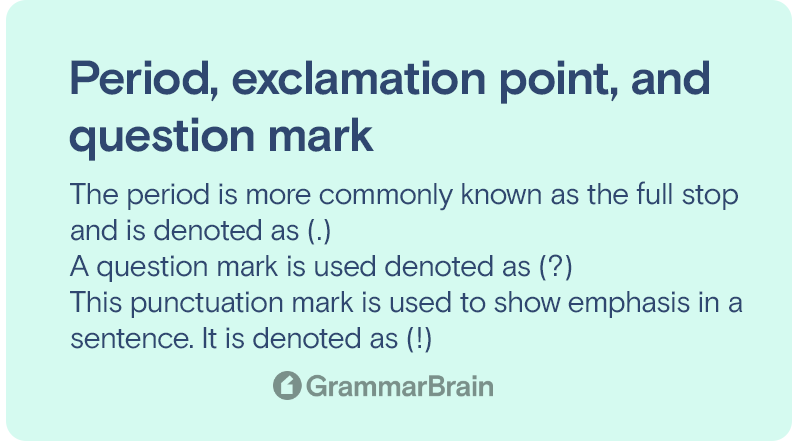
Period, exclamation point, and question mark
All these three punctuation marks are used to end an independent thought. But each of them is used in different instances.
1. Period
- The period is more commonly known as the full stop and is denoted as (.)
- It is one of the most frequently used punctuation marks.
- It is used at the end of a complete sentence or a declarative sentence.
- Sometimes, it is also used to indicate abbreviations of words or phrases.
Examples:
1. Today is a wonderful day.
2. You are to report here on Thursday.
3. Abbreviation examples: Prof. for professor, Jan. for January, Dr. for doctor.
2. Question mark
- A question mark is used denoted as (?)
- It is used to end an interrogative sentence, or as is more commonly known – a question.
- They should only be used at the end of a direct question, and not indirect questions that are a part of a declarative sentence.
- They can also be used to depict uncertainty when placed in parenthesis inside a sentence.
Examples:
1. Would you be able to make it on time?
2. The man took over the business in 1972 [1973?]
3. Exclamation point
- This punctuation mark is used to show emphasis in a sentence. It is denoted as (!)
- It is used to signify a command or a strong emotion.
- It can be used at the end of a sentence.
- When placed at the end of a sentence, it assumes the role of a period.
Examples:
1. I’m so excited! This is fantastic
2. Sit down this instant!
Comma, colon, and semicolon
All of these punctuation marks are used for connecting sentences. Let’s take a look at the purpose of each of these.
4. Comma
- The comma is denoted as (,)
- It is the most commonly confused punctuation mark. It has many different uses, which is why it’s important to be familiar with the rules of using commas.
- Quite often, it is used to show the difference between two separate elements and ideas within a sentence.
- They are also used in writing dates and separating ideas.
Examples:
1. Joining two separate sentences: We went to the market, and to the movies after that.
2. Between a series of words: The man was tall, dark, and handsome.
3. After the words yes and no: Yes, thank you.
4. For separating tag question: He was there, wasn’t he?
5. To address someone directly: Are you free, John?
6. When writing a date: The man died on May 31, 1979.
7. For coordinating adjective: This sweet, happy boy came up to me.
5. Colon
- A colon is denoted as (:)
- This is another punctuation mark that has many uses.
- It’s most commonly used in introducing a series, an example, a quotation, or an explanation.
- It is used to show emphasis.
- Other uses include separating independent clauses, writing time, and textual division of a verse.
Examples:
1. Three pieces of evidence were produced in court: a hair clip, a handkerchief, and an umbrella.
2. Let’s meet at 9:20 am.
3. Father John quotes from Mark 3:6.
4. During the party, she said: “That’s not gonna happen.”
6. Semicolon
- The semicolon is denoted as (;)
- Semicolons are usually used for separating two independent clauses that are closely related to one another.
- In some sentences, semicolons do a better job of showing a connection as opposed to a full stop.
Examples:
1. She couldn’t eat shellfish; she was highly allergic to them.
2. The kid loved to save his Halloween candy; mars bars were his favorite.
Hyphen and dashes
Hyphen, en dash, and em dash are all commonly known as dashes. But they are used for different reasons –
7. Hyphen
- A hyphen is denoted as (-)
- This is most commonly used in forming compound words.
- They are also used in compound modifiers.
Examples:
1. I was visiting my mother-in-law.
2. He said he was pro-choice.
3. He gave her a good-night kiss. (compound modifier)
8. En dash
- An en dash is denoted as (–)
- Em dashes are longer than hyphens, but shorter than em dashes.
- They are named en dashes but they are as wide as the letter N.
- It can have a couple of uses, but it’s most commonly used in representing a range of numbers. It is used in place of ‘to’ or ‘through’.
- They are also used in complex compound adjectives, in representing directions, sports scores, and votes.
Examples:
1. I read the entire book through pages 1–396.
2. The actress starred in many Academy Award-winning films.
3. The employee union voted 10–7 in favor of holding a strike.
4. The Hungary football team defeated the England team 4–0 yesterday.
5. The Dubai–London flight takes around eight hours.
9. Em dash
- Em dashes are denoted as (—)
- They look a lot like the en dashes but are shorter.
- They are named em dashes because they are as wide as the letter M.
- In British English, they are also written in the form of double hyphens (–)
- They are most commonly used to indicate a pause in a sentence.
- Em dashes are often used in place of parenthesis or commas to draw attention or emphasize an element.
Examples:
1. While I was walking—wandering aimlessly through the corridors—I ran into an old friend.
2. Traveling—that is, traveling by train—can be quite relaxing.
3. Lean protein—such as Greek yogurt, white meat poultry, and beans —is an important part of a healthy diet.
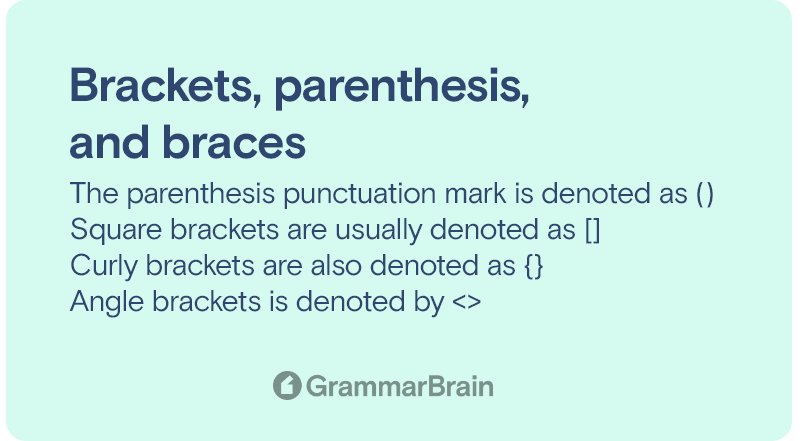
Brackets, parenthesis, and braces
Although these three punctuation marks look somewhat similar, they tend to have different uses. Brackets are further divided into 3 types (curly, square, and angle brackets). The most commonly used punctuation mark among these is the parenthesis, so let’s start with that.
10. Parenthesis
- The parenthesis punctuation mark is denoted as ()
- They are most commonly used to show additional thoughts about a statement.
- In some instances, parenthesis can be used instead of commas too.
- They are also used to provide full forms of abbreviations.
Examples:
1. Noise pollution has increased significantly in the last few years (see the chart below for more information.
2. It’s my favorite time of the year (Christmas)!
3. John Donne (1572–1631) was one of the most popular metaphysical poets of his time.
4 She was announced as the brand ambassador of UNICEF (United Nations International Children’s Emergency Fund).
11. Square brackets
- Square brackets are usually denoted as [].
- They are commonly used for adding information to a quotation.
- They are used to add words that enhance the meaning of some quoted text, without disturbing the original quote.
Examples:
1. For clarifying nouns: The jury said that “the attorney [Mr. Williams] has made it abundantly clear that there is much to still uncover.”
2. For translating foreign words in a text: I wished her good morning, to which she replied, “Bonne Nuit (Good Night)”.
3. For adding the term sic to indicate an error in the quote: The woman at the bar said that “the man came in evry [sic] Thursday and Friday.”
12. Curly brackets
- Curly brackets are also denoted as {}
- They are also known as braces.
- Curly brackets are used for grouping a set of terms together.
- There are the least commonly used brackets.
Examples:
1. She made the grilled cheese with the choicest ingredients {focaccia bread, gouda cheese, caramelized onions, smoked ham}.
2. He helped the kid memorize the colors of the rainbow {violet, indigo, blue, green, yellow, orange, red}.
13. Angle brackets
- Angle brackets is denoted by <>
- Angle brackets are more commonly used in computing and math.
- They don’t usually have much use in formal (or even informal) writing, but some instances of use do exist.
Examples:
1. Aside: The dog got stuck in the fence again. <<Why does he go in there?>>
2. To indicate foreign speech: The man came up to them and asked, “Good day! Which path do I take to reach Champs Elysees?”. The French men: <<What did he say?>>
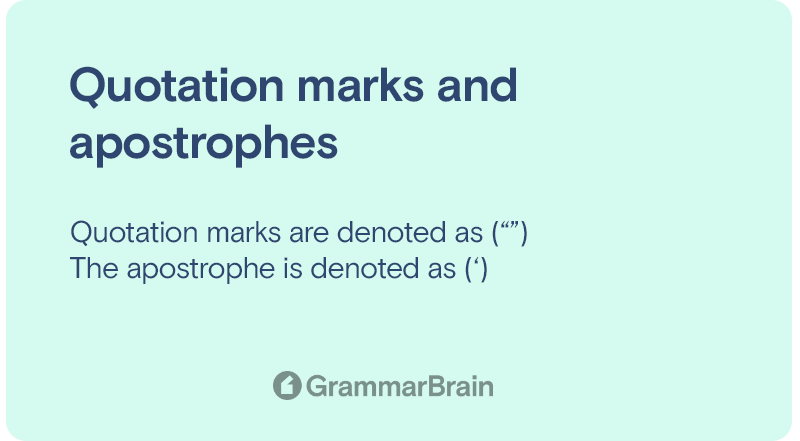
Quotation marks and apostrophes
There are two other similar-looking punctuation marks that many writers can find confusing.
14. Quotation marks
- Quotation marks are denoted as (“”)
- Quotation marks are used to quote something that someone said, in the exact language.
- They are also used to represent speech acts in fiction and poetry.
- Many writers also use quotation marks to emphasize certain words these days.
Examples:
1. The woman said, “We’re taking our dog out for a walk.”
2. Bob Ross loved putting “happy little trees” in his paintings.
15. Apostrophe
- The apostrophe is denoted as (‘)
- It is most commonly used to form contractions and possessives.
- The apostrophe can be used in multiple ways, and it can get quite confusing if the rules of apostrophe usage are not followed.
Examples:
1. Contractions: It’s not a big deal (it is = it’s); They’re making a scene (they are = they’re).
2. To show possession: That book is Adam’s; The student’s name appeared in the newspaper.
3. Apostrophe after S: I went to my boss’ house for dinner. He is a follower of Sophocles’ teachings.
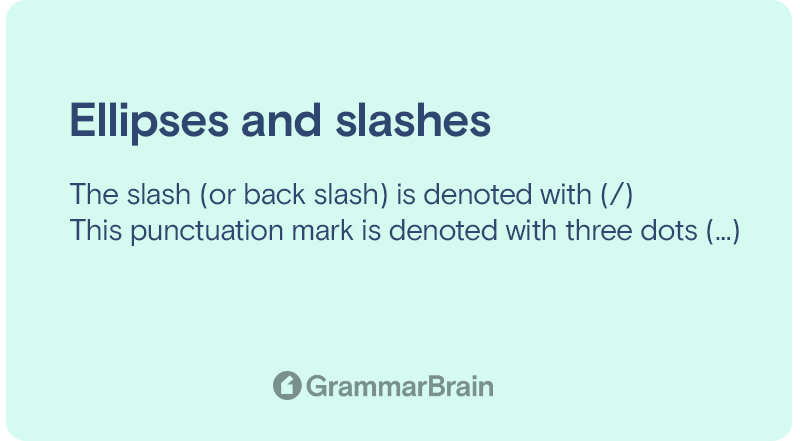
Ellipses and slashes
Although these two punctuation marks are not easily found in writing, there are several ways in which slashes and ellipses can be useful.
16. Slash
- The slash (or back slash) is denoted with (/)
- It is also known as an oblique dash, virgule, or forward slash.
- They are often used in place of the word ‘or’. Besides this, they are also useful for showing two contradictory notions.
- Slashes are also used in poetry to separate the lines of a poem.
Examples:
1. The store accepts credit and/or cash.
2. Poetry: Mary had a little lamb/ little lamb, little lamb/ Mary had a little lamb/ whose fleece was white as snow.
3. The pro-choice/pro-life debate is something people feel quite strongly about.
4. Abbreviations: She switched on the a/c (air conditioning); Bring the forms w/o (without) any additional documents.
5. Fractions: She used only 1/4 of the living room space.
17. Ellipses
- This punctuation mark is denoted with three dots (…)
- It is used when some words have been omitted from a sentence.
- Most commonly, ellipses are used to cut short any irrelevant or unnecessary words.
Examples:
1. The Vice President said, “We’ll ensure that all the damages are paid for… as soon as possible”
2. She nervously said, “Well, you see… I am… Oh, forget it.”
More punctuation marks (all 26 common punctuation marks)
| Symbol | Name | Example |
| . | Period | I got this at the fair. Used as sentence endings. |
| ? | Question mark | How many trucks does he have? |
| ! | Exclamation point / Exclamation mark | Wow! You’re a great rider. |
| , | Comma | I like the movie, but the color grading is odd to me. |
| : | Colon | Here are some fun ideas for the party: trivia questions, shuffle board, and more. |
| ; | Semicolon | I’ll visit you once I’m done with work; that’s a promise. |
| – | Hyphen | I have double-life situations. Used for compound words. Or to join two separate words. |
| – | En dash | How long is a China-Russia fight? |
| — | Em dash | The dog—and I’m afraid of four-legged animals—was so adorable. |
| ( ) | Parentheses | His favorite team (Chicago Bulls) has a chance to win the title. |
| [ ] | Square brackets | The AP writer said “[head] of baseball operations was disappointed.” |
| { } | Curly brackets | The colors {orange, green, lilac, blue} are for the garage. |
| < > | Angle brackets | |
| “ ” | Quotation marks / Quotation mark | Bryan called it a “great situation.” |
| ‘ | Apostrophe | Some of Susan’s clothes are missing. |
| / | Slash or Virgule | I’m ordering food/dessert/more. |
| … | Ellipses | According to the school the “president… was disappointed.” |
| * | Asterisk | *Data from The Economist |
| & | Ampersand | Tiffany & Co. |
| • | Bullet point | • Simple • Great • Awesome |
| # | Pound symbol | #1 selling |
| ~ | Tilde | Bryan owns ~10 pairs of shoes. |
| \ | Backslash | |
| @ | At symbol | [email protected] |
| ^ | Caret symbol | 3^3 = 27 |
| | | Pipe symbol |
Where do punctuation styles differ?
Punctuation comes with a set of rules that dictate how one can use punctuation marks in a piece of writing. But this does not mean that punctuation styles do not differ at all. Some people do not use periods in abbreviations (YMCA), while others use single quotation marks for all instances. The major differences in punctuation style can be found among –
- Individual writers who would most likely have a personal preference when it comes to punctuation rules.
- Book and newspaper publishers usually have their own style guide for setting the specifications of punctuation usage. This can sometimes be according to the set rules, but many publishers prefer to make variations based on their personal preferences.
- American and British English: Punctuation styles also differ between these two forms of English. For instance, time is written as 9.30 in British English, while American English uses semicolons (9:30). Another difference is that common abbreviations like Mr. and Mrs. come with a period. In British English, on the other hand, the period is not used, and these abbreviations are written as Mr and Mrs.
Conclusion
This covers everything about punctuation marks. By now, it is understood that punctuation marks are not just inconsequential bits of decoration. They are crucial for enhancing the readability of a piece of text. If a piece of text is badly punctuated, the reader is bound to have difficulty comprehending its meaning.
FAQs
Why are punctuation marks useful?
Punctuation marks are important for silent intonation. They give the readers cues to stop, pause, question, or emphasize.
Can an interrogation mark and a question mark be used together?
Yes. A combination of these two question marks is an interrobang. It is most commonly used when an exclamation accompanies a question.
Sources:
- Punctuation Marks: Names, Rules, and Useful Examples
- What Are The 14 Punctuation Marks You Need To Know?
- Punctuation
- Punctuation: Everything You Need to Know
- 26 Types of Punctuation Marks & Typographical Symbols
- A Quick Guide to Punctuation
- Guide to Punctuation
Inside this article
Fact checked:
Content is rigorously reviewed by a team of qualified and experienced fact checkers. Fact checkers review articles for factual accuracy, relevance, and timeliness. Learn more.
Core lessons
Glossary
- Abstract Noun
- Accusative Case
- Anecdote
- Antonym
- Active Sentence
- Adverb
- Adjective
- Allegory
- Alliteration
- Adjective Clause
- Adjective Phrase
- Ampersand
- Anastrophe
- Adverbial Clause
- Appositive Phrase
- Clause
- Compound Adjective
- Complex Sentence
- Compound Words
- Compound Predicate
- Common Noun
- Comparative Adjective
- Comparative and Superlative
- Compound Noun
- Compound Subject
- Compound Sentence
- Copular Verb
- Collective Noun
- Colloquialism
- Conciseness
- Consonance
- Conditional
- Concrete Noun
- Conjunction
- Conjugation
- Conditional Sentence
- Comma Splice
- Correlative Conjunction
- Coordinating Conjunction
- Coordinate Adjective
- Cumulative Adjective
- Dative Case
- Determiner
- Declarative Sentence
- Declarative Statement
- Direct Object Pronoun
- Direct Object
- Diction
- Diphthong
- Dangling Modifier
- Demonstrative Pronoun
- Demonstrative Adjective
- Direct Characterization
- Definite Article
- Doublespeak
- False Dilemma Fallacy
- Future Perfect Progressive
- Future Simple
- Future Perfect Continuous
- Future Perfect
- First Conditional
- Irregular Adjective
- Irregular Verb
- Imperative Sentence
- Indefinite Article
- Intransitive Verb
- Introductory Phrase
- Indefinite Pronoun
- Indirect Characterization
- Interrogative Sentence
- Intensive Pronoun
- Inanimate Object
- Indefinite Tense
- Infinitive Phrase
- Interjection
- Intensifier
- Infinitive
- Indicative Mood
- Participle
- Parallelism
- Prepositional Phrase
- Past Simple Tense
- Past Continuous Tense
- Past Perfect Tense
- Past Progressive Tense
- Present Simple Tense
- Present Perfect Tense
- Personal Pronoun
- Personification
- Persuasive Writing
- Parallel Structure
- Phrasal Verb
- Predicate Adjective
- Predicate Nominative
- Phonetic Language
- Plural Noun
- Punctuation
- Punctuation Marks
- Preposition
- Preposition of Place
- Parts of Speech
- Possessive Adjective
- Possessive Determiner
- Possessive Case
- Possessive Noun
- Proper Adjective
- Proper Noun
- Present Participle
- Prefix
- Predicate

